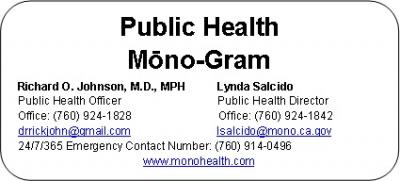Mono-Gram - Washington Fire 6/22/15
Health Effects from Wildfire Smoke
Those of you in Mono County from the communities of Walker and north have undoubtedly seen the smoke from the Washington Fire burning in Alpine County. Although most of the smoke is blowing over us and into Nevada, as the wind has died down during the night, smoke has settled into the valleys this morning. Keep in mind that this is a very fluid and ever changing situation, dependent on the fire, fuel, control efforts, and the wind. Our prayers are with the large numbers of dedicated personnel who are making tremendous efforts to protect all of us, our homes, and the environment.
Some communities in the Eastern Sierra have access to continuous particulate matter (PM) monitoring. These monitors provide an instant reading of particulate matter concentrations averaged over one hour. Smoke from wildfires is a mixture of gases and fine particles from burning trees and other plant materials. It is these fine particles which are contained in wildfire smoke which make it so hazardous to our health. Smoke can hurt your eyes, irritate your respiratory system, and worsen chronic heart and lung diseases.
Unfortunately, there is no monitoring in the areas currently impacted by smoke. Areas without monitoring need other ways to estimate particle levels. The following index is useful in judging the levels near you on a continual basis.
Good (can see 11 miles or more) - No cautionary statements.
Moderate (can see 6-10 miles) - Unusually sensitive people should consider reducing prolonged or heavy exertion.
Unhealthy for Sensitive Groups (can see 3-5 miles) - People with heart or lung disease, older adults, and children should reduce prolonged or heavy exertion.
Unhealthy (can see 1½-3 miles) - People with heart or lung disease, older adults, and children should avoid prolonged or heavy exertion. Everyone else should reduce prolonged or heavy exertion.
Very Unhealthy (can see 1-1½ mile) - People with heart or lung disease, older adults, and children should avoid all physical activity outdoors. Everyone else should avoid prolonged or heavy exertion.
Hazardous (can see 1 mile or less) - Everyone should avoid all physical activity outdoors; people with heart or lung disease, older adults, and children should remain indoors and keep activity levels low.
How to tell if smoke is affecting you
Smoke can cause—
- Coughing
- A scratchy throat
- Irritated sinuses
- Shortness of breath
- Chest pain
- Headaches
- Stinging eyes
- A runny nose
- Asthma exacerbations
If you have heart or lung disease, smoke might make your symptoms worse.
People who have heart disease might experience—
- Chest pain
- Rapid heartbeat
- Shortness of breath
- Fatigue
Smoke may worsen symptoms for people who have pre-existing respiratory conditions, such as respiratory allergies, asthma, and chronic obstructive pulmonary disease (COPD), in the following ways:
- Inability to breathe normally
- Cough with or without mucus
- Chest discomfort
- Wheezing and shortness of breath
When smoke levels are high enough, even healthy people may experience some of these symptoms.
Know whether you are at risk
If you have heart or lung disease, such as congestive heart failure, angina, COPD, emphysema, or asthma, you are at higher risk of having health problems than healthy people.
Older adults are more likely to be affected by smoke, possibly because they are more likely to have heart or lung diseases than younger people.
Children are more likely to be affected by health threats from smoke because their airways are still developing and because they breathe more air per pound of body weight than adults. Children also are more likely to be active outdoors.
What should you be doing:
1. Stay indoors with windows and doors closed; run air-conditioner on “recirculate” setting. Keep the fresh-air intake closed and the filter clean to prevent outdoor smoke from getting inside. Minimize the use of swamp coolers. If it becomes too warm indoors, individuals may consider leaving the area to seek alternative shelter.
2. Do not add to indoor pollution. When smoke levels are high, do not use anything that burns, such as candles, fireplaces, or gas stoves. Do not vacuum, because vacuuming stirs up particles already inside your home. Do not smoke, because smoking puts even more pollution into the air.
3. Follow your doctor's advice about medicines and about your respiratory management plan if you have asthma or another lung disease, Call your doctor if your symptoms worsen. If you evacuate, make sure you take all essential medications along with you.
4. Do not rely on dust masks or N95 respirators for protection. If you wish to wear something, use a wet handkerchief or bandana to cover your mouth and nose. The key – keep it moist.
5. When driving make sure to drive with the windows rolled up and the air conditioner on “recirculate.” Also, buckle up – and do not drink and drive!
6. Minimize or stop outdoor activities, especially exercise, during smoky conditions.
7. People who must spend time outdoors should drink plenty of fluids.
8. Additionally, pet owners should consider bringing their pets indoors out of the unhealthy air conditions, if possible. This is especially important for older pets.
9. Stay tuned to local radio and TV for emergency announcements about air quality.
10. Stay in touch with family and friends, especially if you live alone. Exercise your communications plan.
Power outages
Power outages can be more than an inconvenience. Click on the What You Need to Know When the Power Goes Out page for more information about carbon monoxide poisoning, food safety, safe drinking water, power line hazards and more.
To keep up-to-date on the status of this fire, and for other resources, go to:
http://inciweb.nwcg.gov/incident/4317/
http://www.sierrafront.net/single-media-interest-fire/2015/WASHINGTON


